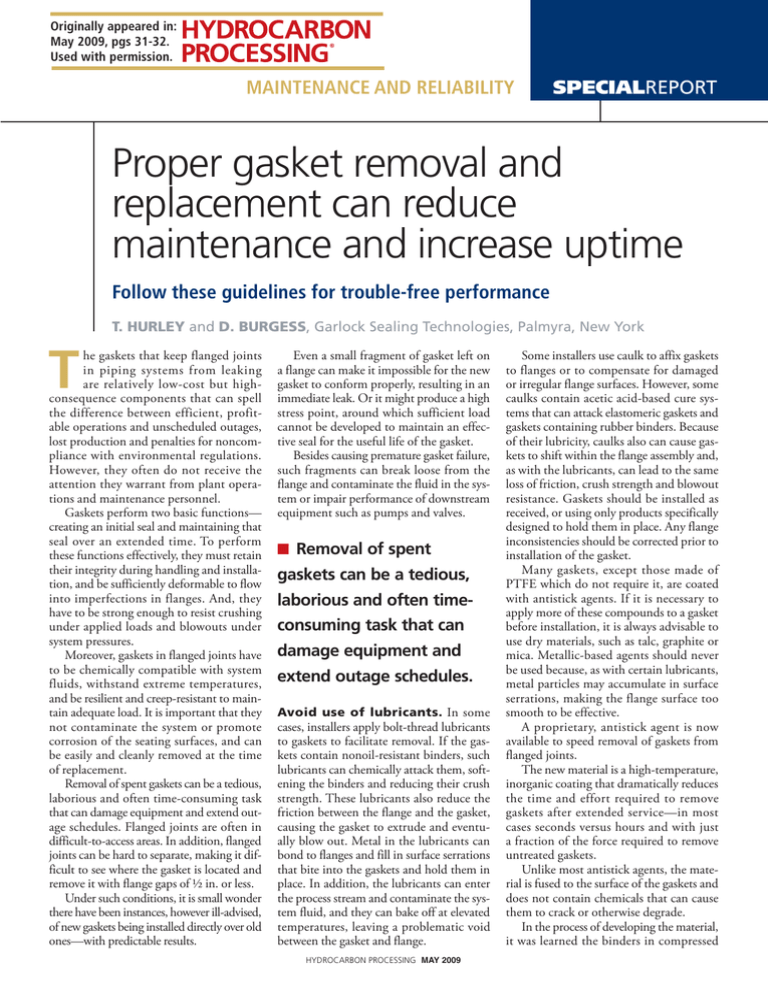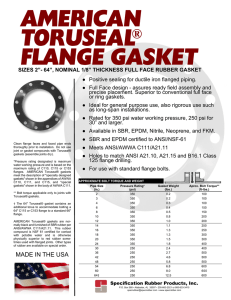
Originally appeared in:
May 2009, pgs 31-32.
Used with permission.
maintenance and reliability
SpecialReport
Proper gasket removal and
replacement can reduce
maintenance and increase uptime
Follow these guidelines for trouble-free performance
T. Hurley and D. Burgess, Garlock Sealing Technologies, Palmyra, New York
T
he gaskets that keep flanged joints
in piping systems from leaking
are relatively low-cost but highconsequence components that can spell
the difference between efficient, profitable operations and unscheduled outages,
lost production and penalties for noncompliance with environmental regulations.
However, they often do not receive the
attention they warrant from plant operations and maintenance personnel.
Gaskets perform two basic functions—
creating an initial seal and maintaining that
seal over an extended time. To perform
these functions effectively, they must retain
their integrity during handling and installation, and be sufficiently deformable to flow
into imperfections in flanges. And, they
have to be strong enough to resist crushing
under applied loads and blowouts under
system pressures.
Moreover, gaskets in flanged joints have
to be chemically compatible with system
fluids, withstand extreme temperatures,
and be resilient and creep-resistant to maintain adequate load. It is important that they
not contaminate the system or promote
corrosion of the seating surfaces, and can
be easily and cleanly removed at the time
of replacement.
Removal of spent gaskets can be a tedious,
laborious and often time-consuming task
that can damage equipment and extend outage schedules. Flanged joints are often in
difficult-to-access areas. In addition, flanged
joints can be hard to separate, making it difficult to see where the gasket is located and
remove it with flange gaps of ½ in. or less.
Under such conditions, it is small wonder
there have been instances, however ill-advised,
of new gaskets being installed directly over old
ones—with predictable results.
Even a small fragment of gasket left on
a flange can make it impossible for the new
gasket to conform properly, resulting in an
immediate leak. Or it might produce a high
stress point, around which sufficient load
cannot be developed to maintain an effective seal for the useful life of the gasket.
Besides causing premature gasket failure,
such fragments can break loose from the
flange and contaminate the fluid in the system or impair performance of downstream
equipment such as pumps and valves.
■ Removal of spent
gaskets can be a tedious,
laborious and often timeconsuming task that can
damage equipment and
extend outage schedules.
Avoid use of lubricants. In some
cases, installers apply bolt-thread lubricants
to gaskets to facilitate removal. If the gaskets contain nonoil-resistant binders, such
lubricants can chemically attack them, softening the binders and reducing their crush
strength. These lubricants also reduce the
friction between the flange and the gasket,
causing the gasket to extrude and eventually blow out. Metal in the lubricants can
bond to flanges and fill in surface serrations
that bite into the gaskets and hold them in
place. In addition, the lubricants can enter
the process stream and contaminate the system fluid, and they can bake off at elevated
temperatures, leaving a problematic void
between the gasket and flange.
HYDROCARBON PROCESSING May 2009
Some installers use caulk to affix gaskets
to flanges or to compensate for damaged
or irregular flange surfaces. However, some
caulks contain acetic acid-based cure systems that can attack elastomeric gaskets and
gaskets containing rubber binders. Because
of their lubricity, caulks also can cause gaskets to shift within the flange assembly and,
as with the lubricants, can lead to the same
loss of friction, crush strength and blowout
resistance. Gaskets should be installed as
received, or using only products specifically
designed to hold them in place. Any flange
inconsistencies should be corrected prior to
installation of the gasket.
Many gaskets, except those made of
PTFE which do not require it, are coated
with antistick agents. If it is necessary to
apply more of these compounds to a gasket
before installation, it is always advisable to
use dry materials, such as talc, graphite or
mica. Metallic-based agents should never
be used because, as with certain lubricants,
metal particles may accumulate in surface
serrations, making the flange surface too
smooth to be effective.
A proprietary, antistick agent is now
available to speed removal of gaskets from
flanged joints.
The new material is a high-temperature,
inorganic coating that dramatically reduces
the time and effort required to remove
gaskets after extended service—in most
cases seconds versus hours and with just
a fraction of the force required to remove
untreated gaskets.
Unlike most antistick agents, the material is fused to the surface of the gaskets and
does not contain chemicals that can cause
them to crack or otherwise degrade.
In the process of developing the material,
it was learned the binders in compressed
maintenance and reliability
sheet gaskets act as visco-elastic materials
that tend to flow at elevated temperatures
and pressures. As the binders “wet out” and
make intimate contact with the metallic
flange face, chemical adhesion, mechanical
interlocking and other modes of adhesion
come into play. The new antistick compound acts as a barrier that prevents the
binders from “wetting out,” and because
they can be removed intact, gaskets treated
with it are easier to dispose of properly.
Proper gasket removal. Replacing
used gaskets begins with removing all flange
fasteners, including bolts, studs, nuts and
washers, and replacing any that are worn,
corroded or otherwise damaged. The flanged
joint should be carefully opened using a special flange-spreading tool or soft wedges so
as not to damage the flange seating surfaces.
The old gasket can then be removed.
This is best accomplished by using an
aerosol gasket remover or, if necessary, a
brass scraper that will not nick, scratch
or gouge the flanges, the surface of which
is critical to achieving the necessary friction for an effective seal. After removing
the old gasket, the flange facings should
be inspected for imperfections that can
adversely affect the new gasket’s ability to
seal. If surface damage exists, it may be
necessary to re-machine or replace the
flange. Acceptable surface finishes should
range between 125 and 250 micro-in.
Flanges should be free of foreign material. Residual debris can be removed from
the serrations by scouring the flange surface
with a brass wire brush in a rotary, not linear, motion. After the old gasket has been
removed and the flange faces cleaned and
conditioned, the replacement gasket can
be installed.
Selecting the new gasket depends upon
a number of variables. Whenever possible,
thinner gaskets should be used unless the
flanges are warped, bowed or severely pitted,
in which case a thicker gasket will be needed
to compensate for these irregularities. It
should be noted, however, that thicker
gaskets require higher compressive loads,
which may not be obtainable in the application. Use of ring gaskets is preferable to
full-face gaskets, which typically cover twice
the area. This extra material also requires
greater torque to compress. Where one or
both flange faces are flat and made of soft or
brittle material, a full-face gasket might be
needed to prevent flange rotation.
Once the replacement gasket has been
selected, it should be inspected for correct
ID, OD and appropriate thickness. If it has
cracks, gouges, folds or other surface damage, it should not be used. For ease of installation, all fasteners should be lubricated with
an oil-and-graphite mixture or other suitable
thread lubricant, being careful not to allow it
to come into contact with the gasket. Flanges
with vertical seating surfaces should have at
least two fasteners inserted into the bottom
holes to support the gasket.
Proper gasket replacement. The
gasket can now be inserted between the
flange seating surfaces, however, care
should be exercised to avoid damaging the
gasket. The flange spreader can then be
carefully removed, allowing the flanges to
come together, and the remaining fasteners
inserted and tightened or “snugged.”
The pattern in which the bolts are
tightened is extremely important. If done
improperly, the flange can move out of
parallel. Refer to the gasket manufacturer’s literature to determine the appropriate bolting pattern for the application.
Using calibrated torque and box-end type
wrenches, tighten each fastener to no more
than one-third of the desired torque value
to uniformly compress the gasket. Repeating the same pattern, increase the torque
wrench setting to two-thirds of the desired
value.
To achieve the final torque value, repeat
the pattern again at the target torque value,
and finish with a circular “check pass,”
moving from one fastener to the next in a
counter-clockwise sequence to ensure each
fastener is applying the same load. The gasket
should now be properly installed and capable
of operating at a high performance level.
The process of removing and replacing
used gaskets is every bit as critical as initial
gasket selection and installation. Antistick
agents, aerosol gasket removers and specialized tools all can facilitate gasket removal
without damaging flanges. Provided flanges
have been cleaned, repaired or replaced as
needed and the replacement gasket has
been installed properly, the flanged joint
should provide trouble-free performance
until the next changeout is scheduled. HP
Tim Hurley is senior product
manager, gasketing for Garlock Sealing Technologies.
Dave Burgess is senior applications engineer for Garlock Sealing
Technnolgies.
Article copyright © 2009 by Gulf Publishing Company. All rights reserved.
Printed in U.S.A.
Not to be distributed in electronic or printed form, or posted on a Website, without express written permission of copyright holder.

